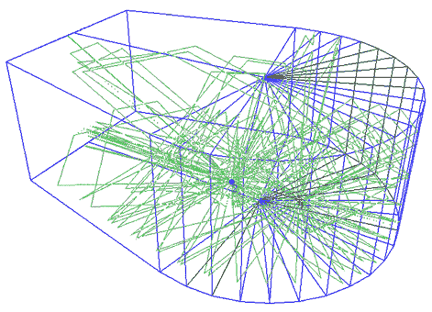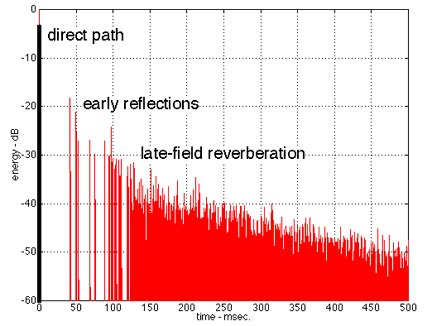Ask the Doctors! Drs. David P. Berners and Jonathan S. Abel Answer Your Signal Processing Questions.
|
& Jonathan S. Abel |
--mattsaudio, via email
A: The short answer is that the early reflection engine and late-field processing have been substantially reworked in order to improve the realism and add flexibility. Because of its psychoacoustic importance, we concentrated on the late field onset, adding mechanisms to provide control over:
- the initial late field echo density
- the late field onset energy profile
- the wet signal equalization (five-band with variable band edges)
We also introduced a more detailed early reflection model, with:
- early reflections having separate materials filters
- adjustible reflection windowing
The long answer involves giving an outline of the physics of reverberation in general. Hopefully this will help you better understand the inner working's of whatever reverberator you are using, including Dreamverb and Realverb Pro.
So, here's what happens to sound in a reverberant environment: Signals radiated from a source interact with the objects and surfaces in the space to create reflections. These reflections undergo further interactions, each generating additional reflections. In an enclosed space, the echo density increases over time to the point that the sound heard by a listener has contributions from such a large number of source reflections that it is Gaussian noise.
 |
|
Figure 1. Reflective Environment
|
 |
|
|
“In Dreamverb, particular attention is paid to the early part of the late field. Being louder and arriving first, it is psychoacoustically important.”
There are roughly three components to the impulse response: the direct path, early reflections, and the late-field reverberation or simply late-field. The direct path represents the signal arriving directly from the source. Early reflections appear after the direct path, and are those arrivals which stand out from the other reflected energy by being separated either in arrival time or arrival energy. Finally, late-field reverberation is the noise-like combination of the remaining arrivals.
Like the direct path, early reflections are characterized by their arrival direction, time, and amplitude. Early reflections also arrive with an equalization resulting from interactions with surfaces and objects encountered on the way to the listener. Many surface materials such as carpet and acoustic tile absorb high frequencies more than low frequencies, and therefore impose a low-pass characteristic on the reflected signal. On the other hand, materials such as glass and plywood are extremely reflective at high frequencies and modestly absorbing at low frequencies.
In order to improve the realism of a reverberator, it is clear that we must look at refining the Early Reflections, Late Field & precise Frequency Filtering characteristics to mimic real world acoustic behaviours. In Dreamverb we have done exactly that, substantially upgrading Realverb in the following key areas:
- Late Field Echo Density at the Impulse onset
- Early Reflections Filtering according to Material properties
- Late Field Initial Energy/Onset Ramp Control
- Advanced Filtering/Equalization ( 5-Band Control )
Like RealVerb Pro, Dreamverb uses a physical model of the acoustic space to generate the early reflections. The image method (as illustrated in Figure 1) is used to compute early reflection arrival times, amplitudes, and directions; a user-selected blend of room materials together with the listening geometry determines equalizations applied to the individual reflections. Also available is a windowing of the early reflections, so that the reflections may be faded in, faded out, or left untouched as determined by the goemetry of the space.
Because of its statistical nature, the late field is often characterized by two quantities: its overall equalization and decay rate as a function of frequency. Geometric details do matter, and tend to effect the transition between distinct early reflections and the noise-like late field. A cluttered space or one with irregularly shaped surfaces will have a room response which quickly transitions to a ``diffuse'' late field.
In Dreamverb, particular attention is paid to the early part of the late field. Being louder and arriving first, it is psychoacoustically important. A diffusion control allows adjustment of the time taken to transition from isolated early reflections to Gaussian noise---from on the order of 50 milliseconds to about a second. The initial part of the late field energy envelope is important, and Dreamverb provides a control allowing the late field to be faded in over about a hundred milliseconds, or to start instantly.
If the space is only partially enclosed, the late field will decay quickly since over any period of time a portion of the energy exits the space. In an enclosed space, the materials composition and room size have strong influences on decay rate. Consider that as the late-field response progresses, the arriving energy has undergone an increasing number of interactions with surfaces and objects in the space, and has traveled through an increasing amount of air. Accordingly, if the materials present preferentially absorb high-frequency energy, then energy at high frequencies is expected to decay quicker than at low frequencies. Air soaks up high frequencies, and even in environments dominated by highly reflective materials (a cathedral with stone walls, say), the high frequencies decay more quickly than do the low frequencies.
Overall decay rate is controlled directly in Dreamverb, with the decay rate as a function of frequency determined by the selected blend of materials and propagation medium. The three-way blend among the two materials and propagation medium allows control over the relative importance of the two materials and propagation medium in determining decay rate as a function of frequency. To give the feel of a large space, since over any given time interval there are relatively fewer interactions with the surfaces of the space, a greater portion of the propagation medium should be used.